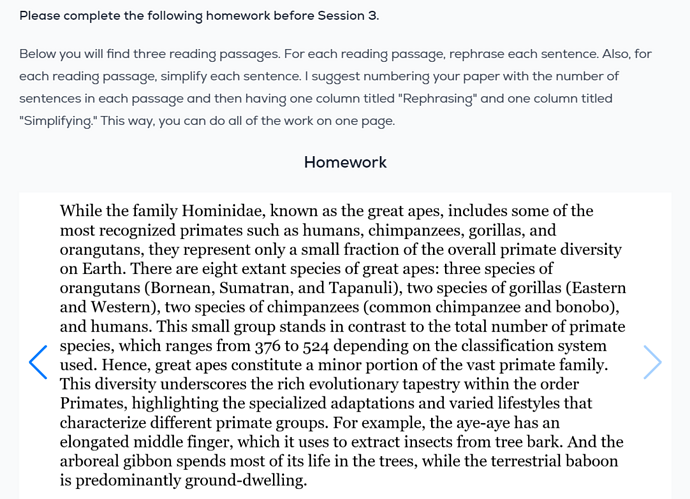Where is the solution to this passage posted? Please link it here. Greg said in session 3 that he will be posting it somewhere.
Hi, can you check Session 4 as well?
No not there in session 4 as well
@gregmat can you check on this one please?
It’s highly probable that I just forgot. You can find a pretty good rephrasing or simplification of it by just putting it into chatgpt:
Original: While the family Hominidae, known as the great apes, includes some of the most recognized primates such as humans, chimpanzees, gorillas, and orangutans, they represent only a small fraction of the overall primate diversity on Earth.
Simplified: Great apes include humans but are a small primate group.
Original: There are eight extant species of great apes: three species of orangutans (Bornean, Sumatran, and Tapanuli), two species of gorillas (Eastern and Western), two species of chimpanzees (common chimpanzee and bonobo), and humans.
Simplified: Eight species of great apes exist, including humans.
Original: This small group stands in contrast to the total number of primate species, which ranges from 376 to 524 depending on the classification system used.
Simplified: Great apes are few compared to 376-524 total primate species.
Original: Hence, great apes constitute a minor portion of the vast primate family.
Simplified: Great apes are a small part of primates.
Original: This diversity underscores the rich evolutionary tapestry within the order Primates, highlighting the specialized adaptations and varied lifestyles that characterize different primate groups.
Simplified: Primate diversity shows their evolution and different adaptations.
Original: For example, the aye-aye has an elongated middle finger, which it uses to extract insects from tree bark.
Simplified: The aye-aye uses its long finger to find insects.
Original: And the arboreal gibbon spends most of its life in the trees, while the terrestrial baboon is predominantly ground-dwelling.
Simplified: Gibbons live in trees; baboons mostly live on the ground.
Oh yes, thanks
